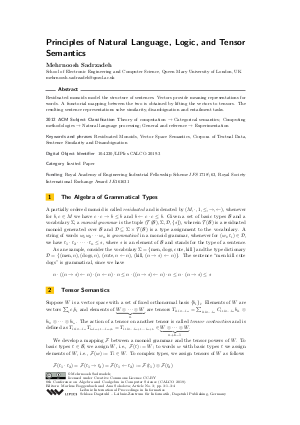Principles of Natural Language, Logic, and Tensor Semantics (Invited Paper)
Author Mehrnoosh Sadrzadeh
-
Part of:
Volume:
8th Conference on Algebra and Coalgebra in Computer Science (CALCO 2019)
Part of: Series: Leibniz International Proceedings in Informatics (LIPIcs)
Part of: Conference: Conference on Algebra and Coalgebra in Computer Science (CALCO) - License:
 Creative Commons Attribution 3.0 Unported license
Creative Commons Attribution 3.0 Unported license
- Publication Date: 2019-11-25
File

PDF
LIPIcs.CALCO.2019.3.pdf
- Filesize: 300 kB
- 4 pages
Document Identifiers
Subject Classification
ACM Subject Classification
- Theory of computation → Categorical semantics
- Computing methodologies → Natural language processing
- General and reference → Experimentation
Keywords
- Residuated Monoids
- Vector Space Semantics
- Corpora of Textual Data
- Sentence Similarity and Disambiguation
Metrics
- Access Statistics
-
Total Accesses (updated on a weekly basis)
0Document
0Metadata
Abstract
Residuated monoids model the structure of sentences. Vectors provide meaning representations for words. A functorial mapping between the two is obtained by lifting the vectors to tensors. The resulting sentence representations solve similarity, disambiguation and entailment tasks.
Cite As Get BibTex
Mehrnoosh Sadrzadeh. Principles of Natural Language, Logic, and Tensor Semantics (Invited Paper). In 8th Conference on Algebra and Coalgebra in Computer Science (CALCO 2019). Leibniz International Proceedings in Informatics (LIPIcs), Volume 139, pp. 3:1-3:4, Schloss Dagstuhl – Leibniz-Zentrum für Informatik (2019)
https://doi.org/10.4230/LIPIcs.CALCO.2019.3
BibTex
@InProceedings{sadrzadeh:LIPIcs.CALCO.2019.3,
author = {Sadrzadeh, Mehrnoosh},
title = {{Principles of Natural Language, Logic, and Tensor Semantics}},
booktitle = {8th Conference on Algebra and Coalgebra in Computer Science (CALCO 2019)},
pages = {3:1--3:4},
series = {Leibniz International Proceedings in Informatics (LIPIcs)},
ISBN = {978-3-95977-120-7},
ISSN = {1868-8969},
year = {2019},
volume = {139},
editor = {Roggenbach, Markus and Sokolova, Ana},
publisher = {Schloss Dagstuhl -- Leibniz-Zentrum f{\"u}r Informatik},
address = {Dagstuhl, Germany},
URL = {https://drops.dagstuhl.de/entities/document/10.4230/LIPIcs.CALCO.2019.3},
URN = {urn:nbn:de:0030-drops-114312},
doi = {10.4230/LIPIcs.CALCO.2019.3},
annote = {Keywords: Residuated Monoids, Vector Space Semantics, Corpora of Textual Data, Sentence Similarity and Disambiguation}
}
Author Details
Funding
Royal Academy of Engineering Industrial Fellowship Scheme IFS1718\63, Royal Society International Exchange Award IE161631
References
-
K. Ajdukiewicz. Die syntaktische Konnexitat. Studia Philosophica, 1:1-27, 1935.

-
Y. Bar-Hillel. A quasi-arithmetical notation for syntactic description. Language, 29:47-58, 1953.

-
M. Baroni and R. Zamparelli. Nouns are vectors, adjectives are matrices: Representing adjective-noun constructions in semantic space. In Conference on Empirical Methods in Natural Language Processing, Cambridge, MA, 2010.

-
Noam Chomsky. Three models for the description of language. IRE Transactions on Information Theory, 2:113-124, 1956.

-
Stephen Clark and Stephen Pulman. Combining Symbolic and Distributional Models of Meaning. In Proceedings of the AAAI Spring Symposium on Quantum Interaction, pages 52-55, 2007.

-
B. Coecke, M. Sadrzadeh, and S. Clark. Mathematical Foundations for Distributed Compositional Model of Meaning. Lambek Festschrift. Linguistic Analysis, 36:345-384, 2010.

-
Bob Coecke, Edward Grefenstette, and Mehrnoosh Sadrzadeh. Lambek vs. Lambek: Functorial vector space semantics and string diagrams for Lambek calculus. Annals of Pure and Applied Logic, 164(11):1079-1100, 2013. Special issue on Seventh Workshop on Games for Logic and Programming Languages.

-
J.R. Firth. A Synopsis of Linguistic Theory 1930-1955. In Studies in Linguistic Analysis. Longmans, 1957.

-
E. Grefenstette, G. Dinu, Y. Zhang, M. Sadrzadeh, and M. Baroni. Multi-Step Regression Learning for Compositional Distributional Semantics. In 10th International Conference on Computational Semantics, Postdam, 2013.

-
E. Grefenstette and M. Sadrzadeh. Experimental Support for a Categorical Compositional Distributional Model of Meaning. In Proceedings of Conference on Empirical Methods in Natural Language Processing, pages 1394-1404, 2011.

-
Edward Grefenstette and Mehrnoosh Sadrzadeh. Concrete Models and Empirical Evaluations for the Categorical Compositional Distributional Model of Meaning. Computational Linguistics, 41:71-118, 2015.

-
Z.S. Harris. Distributional structure. Word, 1954.

-
D. Kartsaklis and M. Sadrzadeh. Prior Disambiguation of Word Tensors for Constructing Sentence Vectors. In Proceedings of Conference on Empirical Methods in Natural Language Processing, 2013.

-
Dimitri Kartsaklis, Nal Kalchbrenner, and Mehrnoosh Sadrzadeh. Resolving Lexical Ambiguity in Tensor Regression Models of Meaning. In Proceedings of the 52nd Annual Meeting of the Association for Computational Linguistics, Baltimore, MD, USA, Volume 2: Short Papers, pages 212-217, 2014.

-
J. Lambek. The mathematics of sentence structure. American Mathematics Monthly, 65, 1958.

-
J. Lambek. Type grammars revisited. In proceedings of LACL 97, volume 1582 of Lecture Notes in Artificial Intelligence. Springer Verlag, 1997.

-
Jean Maillard and Stephen Clark. Learning adjective meanings with a tensor-based skip-gram model. In Proceedings of the Nineteenth Conference on Computational Natural Language Learning, pages 327-331, 2015.

-
Tomas Mikolov, Ilya Sutskever, Kai Chen, Greg S Corrado, and Jeff Dean. Distributed representations of words and phrases and their compositionality. In Advances in neural information processing systems, pages 3111-3119, 2013.

-
Dmitrijs Milajevs, Dimitri Kartsaklis, Mehrnoosh Sadrzadeh, and Matthew Purver. Evaluating Neural Word Representations in Tensor-Based Compositional Settings. In Proceedings of the 2014 Conference on Empirical Methods in Natural Language Processing, pages 708-719. Association for Computational Linguistics, 2014.

-
Mati Pentus. Lambek Grammars Are Context Free. In In Proceedings of the Eighth Annual IEEE Symposium on Logic in Computer Science, pages 429-433. IEEE Computer Society Press, 1993.

-
Tamara Polajnar, Luana Fagarasan, and Stephen Clark. Reducing dimensions of tensors in type-driven distributional semantics. In Proceedings of the Conference on Empirical Methods in Natural Language Processing, pages 1036-1046, 2014.

-
A. Preller and M. Sadrzadeh. Bell States and Negative Sentences in the Distributed Model of Meaning. In P. Selinger B. Coecke, P. Panangaden, editor, Electronic Notes in Theoretical Computer Science, Proceedings of the 6th Workshop on Quantum Physics and Logic, volume 270, pages 141-153, 2010.

-
Anne Preller and Joachim Lambek. Free compact 2-categories. Mathematical Structures in Computer Science, 17:309-340, 2007.

-
H. Rubenstein and J.B. Goodenough. Contextual Correlates of Synonymy. Communications of the ACM, 8(10):627-633, 1965.

-
M. Sadrzadeh. Unifying the Mathematics of Natural Language Grammar and Data. London Mathematical Society News Letter, pages 25-31, 2018.

-
Mehrnoosh Sadrzadeh, Dimitri Kartsaklis, and Esma Balkır. Sentence entailment in compositional distributional semantics. Annals of Mathematics and Artificial Intelligence, 82(4):189-218, 2018.

-
G. Salton, A. Wong, and C. S. Yang. A Vector Space Model for Automatic Indexing. Commun. ACM, 18:613-620, 1975.

